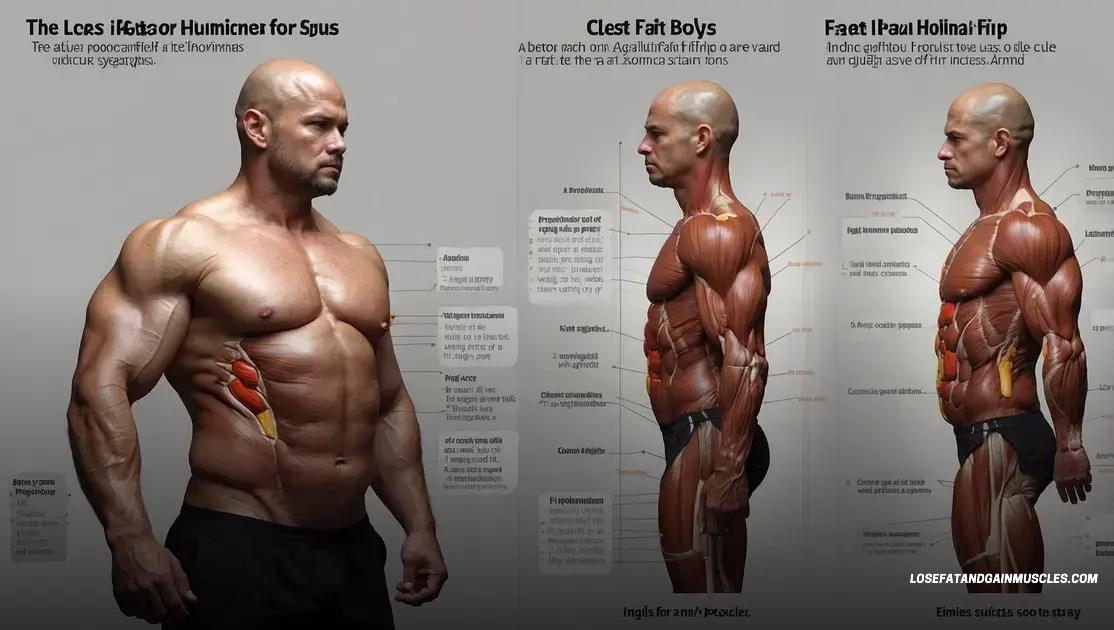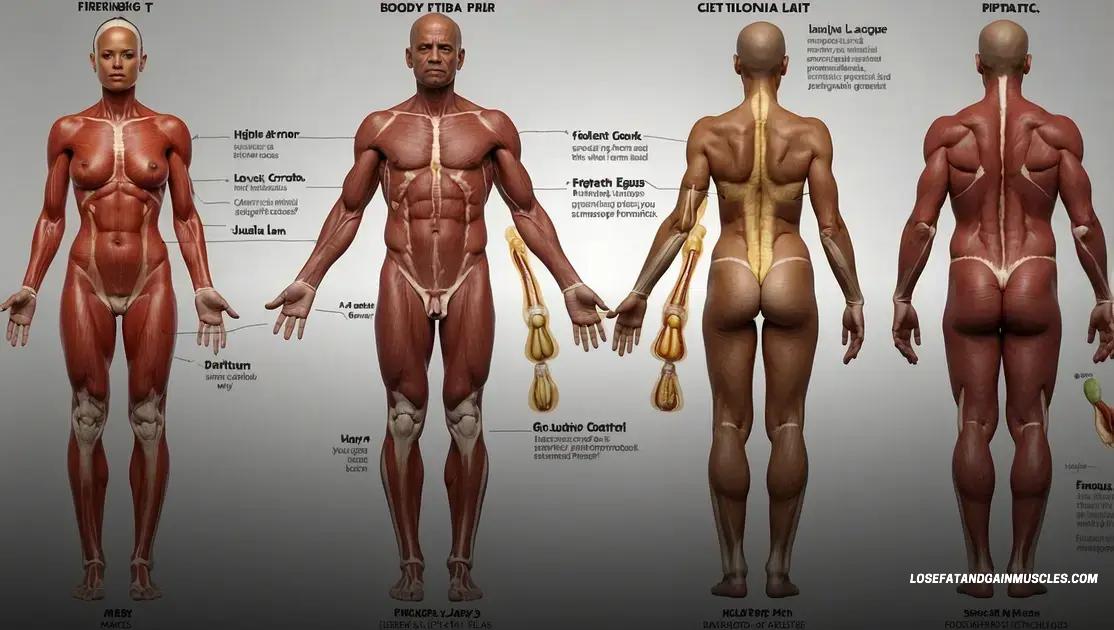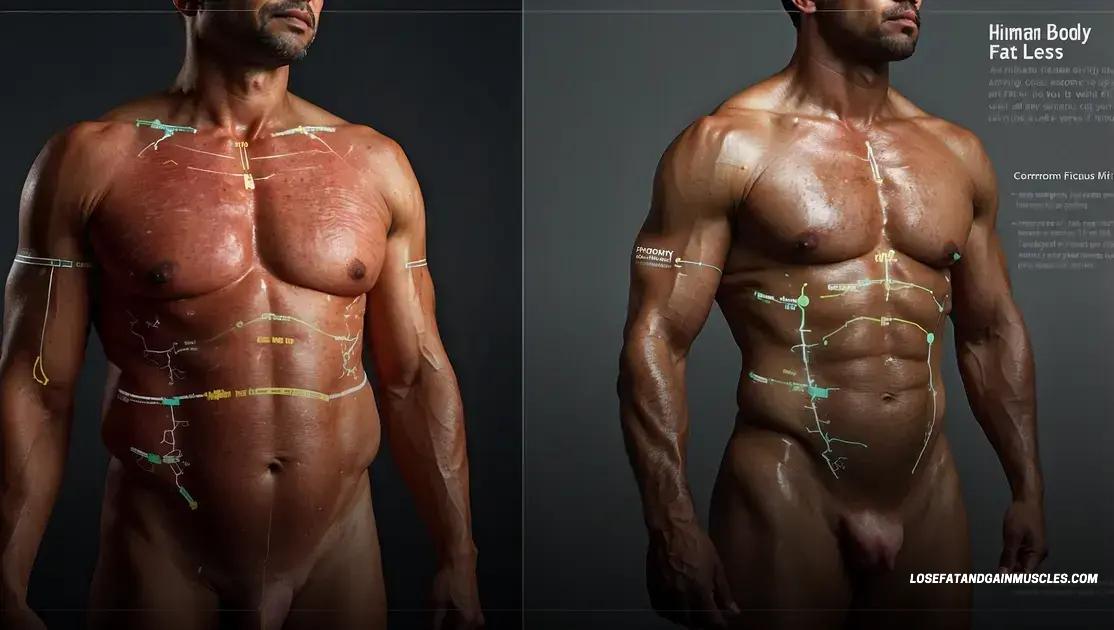Where Do You Lose Fat First? Discover the Science and Areas for Effective Fat Loss
When aiming for fat loss, the first areas typically include the abdomen, thighs, and face. Factors like genetics, diet, exercise, and hormones influence fat distribution and loss. Combining cardio, strength training, and a balanced diet is key to effectively targeting specific fat areas.
Where do you lose fat first? This question is one many people ask when embarking on their fat loss journey. Understanding the fat loss patterns is science-based and can significantly impact your approach. Whether you’re targeting specific areas or striving for overall body fat reduction, knowing where fat typically burns first is crucial. In this article, we will delve into common areas for fat loss, discuss the science behind these processes, and provide tips to help you achieve your goals.
Understanding the Fat Loss Process
Understanding the fat loss process is vital for anyone looking to improve their health and physique. The human body burns fat through a complex biochemical process, which involves both energy intake and energy expenditure. When you consume fewer calories than your body needs, it begins to tap into stored fat for energy.
How the Body Uses Fat
When your body needs energy, it breaks down fat cells to release fatty acids. These fatty acids can then be used as fuel during various activities, from exercising to daily living tasks. The rate at which your body burns fat depends on several factors, including your metabolism, workout intensity, and overall nutrition.
Caloric Deficit and Fat Loss
A caloric deficit is a fundamental concept in fat loss. You achieve a caloric deficit by consuming fewer calories than your body expends. This deficit forces your body to use stored fat for energy, leading to fat loss over time. It’s important to ensure that any weight loss plan provides enough nutrients to support overall health.
Metabolism’s Role
Your metabolism plays a crucial role in determining how quickly you lose fat. Factors like age, sex, and muscle mass can affect your metabolic rate. Incorporating strength training can help increase your muscle mass, which can boost your metabolism and enhance fat loss.
Fat Loss Patterns
It’s also essential to recognize that fat loss doesn’t occur uniformly across the body. Typically, individuals may notice they lose fat in certain areas first, depending on genetic factors. This process varies greatly from person to person, and understanding this can help in setting realistic goals.
Importance of Consistency
Finally, consistency is key in the fat loss process. Adopting healthy eating habits and maintaining a regular exercise routine over time is crucial for sustainable results. Rapid weight loss might be tempting, but slow and steady wins the race, leading to healthier body fat changes in the long run.
Common Areas for Fat Loss

When it comes to common areas for fat loss, individuals may notice differences based on their body type and genetic makeup. Certain regions tend to shed fat more readily than others, and understanding these areas can aid in setting realistic goals.
Abdominal Area
The abdominal area is often one of the first places people aim to lose fat. Many individuals notice a reduction in belly fat with consistent exercise and a proper diet. Targeted workouts, such as crunches and planks, can assist in strengthening the muscles in this region.
Thighs
While challenging for some, thigh fat is another common area for individuals to experience loss. Many exercises, like squats and lunges, can help tone this area and contribute to fat reduction. However, genetics also play a role in how fat is distributed and shed from the thighs.
Arms
Many people find that arm fat reduces with a combination of strength training and cardio. Exercises such as push-ups and tricep dips target the upper arms specifically, helping to promote fat loss and muscle definition in those areas.
Chest
Like the arms, the chest area can also experience fat loss with focused workouts. Strength training exercises that enhance the pectoral muscles can help tone this area, leading to a leaner appearance over time.
Face
Finally, many individuals notice that they lose fat in their face early in their fat loss journey. This is often one of the more noticeable changes, as fat loss can lead to a more defined jawline and cheekbones. While it can be hard to target fat loss in the face specifically, overall weight loss contributes significantly to changes in facial fat.
Factors Influencing Where Fat Burns First
Several factors influence where fat burns first when you begin your fat loss journey. Understanding these factors can help manage expectations and improve your strategy.
Genetics
Your genetics play a significant role in determining where you lose fat. Genetic factors influence body fat distribution and how easily you shed fat in certain areas. Some people may notice rapid fat loss in the abdomen, while others might see changes in their thighs or arms first.
Gender
Gender is another key factor. Typically, women tend to store fat in their hips and thighs, while men usually store fat in their abdomen. This difference influences fat loss patterns, affecting how each gender experiences changes during a weight loss program.
Age
Your age also impacts fat loss. As people age, metabolism tends to slow down, making fat loss more challenging. Additionally, hormonal changes related to aging can shift the body’s fat storage patterns, influencing where fat burns first.
Diet and Nutrition
The type of diet you follow can also affect fat loss. A balanced diet with the right nutrients can improve metabolism and support more effective fat burning. Diets high in protein can also promote fat loss and muscle building, leading to a higher rate of fat reduction overall.
Activity Level
Your activity level plays a crucial role in fat loss. Regular exercise can boost your metabolism and help burn fat more efficiently. Different types of workouts, such as strength training or high-intensity interval training, can also target fat loss in specific areas differently.
The Science Behind Body Fat Loss Locations

The science behind body fat loss locations is fascinating and complex. Understanding how your body loses fat in specific areas involves a blend of physiology and biochemistry. Different types of fat are stored in various parts of the body, and fat loss can vary based on numerous factors.
Types of Body Fat
There are primarily two types of body fat: subcutaneous fat and visceral fat. Subcutaneous fat is located just under the skin and is found in areas such as the thighs and arms. Visceral fat, on the other hand, surrounds your organs and is typically located in the abdomen. Research shows that visceral fat is often burned off first, especially during weight loss.
Hormonal Influence
Hormones play a critical role in where and how fat is stored and burned. Insulin, for example, regulates fat storage. High levels of insulin can promote fat accumulation, particularly in the abdominal area, while lower insulin levels can help mobilize fat for energy.
Metabolism and Fat Oxidation
Every individual’s metabolism affects how fat is lost. Fat oxidation refers to the process where fatty acids are broken down for energy. Factors that influence this process include your age, sex, muscle mass, and overall metabolic rate. Generally, those with a higher muscle mass will burn fat more efficiently.
Energy Balance
Understanding energy balance is essential in fat loss. When you consume more calories than you expend, your body will store the excess as fat. In contrast, creating a caloric deficit enables the body to use stored fat for energy, impacting where the fat is lost first.
Genetic Predisposition
Finally, genetic factors can determine your body’s fat loss locations. Your genes can affect how your body responds to exercise and dieting, influencing overall fat distribution and loss patterns. Some individuals may find they lose fat more readily in their upper body, while others lose fat first in their lower body.
Tips for Targeting Specific Fat Loss Areas
Targeting specific fat loss areas requires a thoughtful approach. Here are some tips for targeting fat loss in various parts of your body.
1. Combine Cardio with Strength Training
To effectively lose fat, combine cardio exercises with strength training. Cardio workouts, such as jogging or cycling, can help burn calories, while strength training can build muscle. Both types of exercise will enhance your fat loss efforts.
2. Focus on Targeted Workouts
Incorporating targeted workouts can help in fat loss for specific areas. For example, incorporating exercises like squats and lunges can help reduce thigh fat, while push-ups and tricep dips can target the arms. These exercises strengthen the muscles in these areas, promoting a leaner appearance.
3. Maintain a Healthy Diet
A balanced diet is key to overall fat loss. Focus on eating whole foods, including lean proteins, whole grains, fruits, and vegetables. Reducing processed food and sugar intake can enhance your fat loss journey and target specific areas more effectively.
4. Stay Hydrated
Drinking plenty of water is crucial in any fat loss program. Staying hydrated helps your metabolism function efficiently and can reduce hunger, making it easier to maintain a caloric deficit essential for fat loss.
5. Get Enough Rest
Don’t underestimate the importance of rest and recovery. Ensuring that you get enough sleep can improve your hormonal balance, affecting your weight loss efforts. Sleep helps your body recover from workouts and regulate appetite hormones.
Understanding Fat Loss for Better Results
In summary, knowing where you lose fat first and how to target specific areas can significantly enhance your fat loss journey. By combining cardio with strength training, adhering to a balanced diet, and considering factors like hydration and rest, you can optimize your results effectively.
It’s vital to recognize that fat loss patterns are influenced by genetics, hormones, and overall body composition. By applying proven strategies and understanding the science behind fat loss, you position yourself for success on your journey to a healthier lifestyle.
Don’t forget that patience and consistency are key. With dedication and the right approach, you can achieve your fat loss goals and improve your overall health.
FAQ – Frequently Asked Questions about Fat Loss
Where do you lose fat first?
Fat loss patterns vary by individual, but many people notice fat loss in their abdomen, thighs, and face first.
What factors influence where fat burns first?
Factors include genetics, gender, age, diet, activity level, and hormonal balance, all affecting fat distribution and loss.
Can targeted exercises help in fat loss?
Yes, targeted exercises can help strengthen specific areas like arms or thighs, but they won’t guarantee fat loss in those areas alone.
How important is diet in fat loss?
Diet plays a crucial role; maintaining a caloric deficit and eating a balanced diet supports effective fat loss.
Does hydration affect fat loss?
Staying hydrated is essential for metabolism and can help control hunger, making it easier to achieve fat loss goals.
Why is rest important for fat loss?
Adequate rest allows your body to recover and helps regulate hormones, which can improve appetite control and fat loss.













